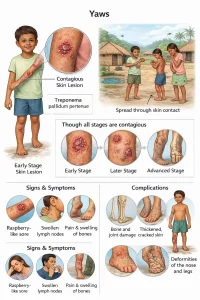Overview
Yaws is a chronic bacterial infection that mainly affects the skin, bones and joints. It is caused by the bacterium Treponema pallidum pertenue, which is closely related to the bacterium that causes syphilis. Yaws is not a sexually transmitted infection.
The disease is most common in warm, humid, tropical regions, particularly in parts of Africa, Southeast Asia, the Pacific Islands and Latin America. It mainly affects children living in rural areas with poor sanitation and limited access to healthcare.
Yaws spreads through direct skin-to-skin contact with the fluid from an infected sore. The infection often begins with a skin lesion and, if left untreated, can progress over years to cause more serious damage to bones and joints. Early diagnosis and treatment with antibiotics can cure yaws and prevent long-term complications.
Symptoms
Yaws develops in stages, and symptoms may appear weeks after exposure. The early stage mainly affects the skin, while later stages can involve deeper tissues.
Common symptoms of yaws include:
-
A painless, round or oval skin sore that may look like a raspberry
-
Thickened or crusted skin lesions, often on the arms, legs or face
-
Itching or mild discomfort at the site of the lesion
-
Swollen lymph nodes near the affected area
If untreated, yaws can progress and cause:
-
Multiple skin sores that may heal and return
-
Bone and joint pain
-
Swelling of fingers or toes
-
Thickening and cracking of the skin on the palms and soles
Causes
Yaws is caused by infection with Treponema pallidum pertenue, a spiral-shaped bacterium. The bacteria enter the body through small cuts or breaks in the skin.
The infection spreads through:
-
Direct contact with the fluid from an active yaws sore
-
Close skin-to-skin contact, especially among children
Poor hygiene, overcrowded living conditions and lack of clean water increase the spread of the bacteria. Yaws is not spread through sexual contact and does not involve the nervous system or heart in the way syphilis can.
Risk factors
Certain factors increase the risk of developing yaws, including:
-
Living in tropical or subtropical regions
-
Being a child, especially between the ages of 2 and 15
-
Poor sanitation and limited access to clean water
-
Close contact with someone who has untreated yaws
-
Living in rural or remote communities with limited healthcare services
Yaws is more likely to spread in communities where the disease is already present and untreated cases remain common.
Complications
If yaws is not treated, it can lead to serious and permanent complications over time, such as:
-
Chronic skin ulcers and scarring
-
Deformities of the bones and joints
-
Swelling and damage to the nose, legs or arms
-
Difficulty walking due to bone and joint damage
-
Social stigma and reduced quality of life due to visible deformities
Although yaws is rarely life-threatening, advanced disease can cause significant disability.
Prevention
Yaws can be prevented and controlled through early detection and treatment, as well as public health measures.
Prevention strategies include:
-
Prompt treatment of infected individuals with antibiotics
-
Treating close contacts in affected communities
-
Improving personal hygiene and access to clean water
-
Health education to recognize early skin lesions
-
Community-wide treatment programs in areas where yaws is common
With effective public health efforts and antibiotic treatment, yaws can be cured and eliminated as a public health problem.
Advertisement

